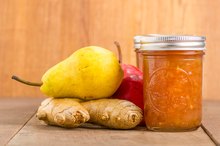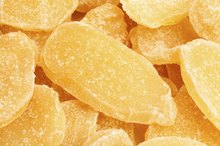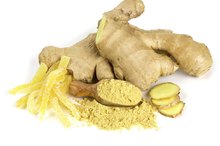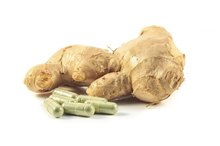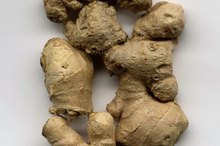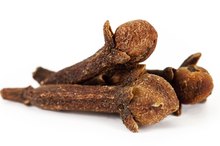What does fact checked mean?
At Healthfully, we strive to deliver objective content that is accurate and up-to-date. Our team periodically reviews articles in order to ensure content quality. The sources cited below consist of evidence from peer-reviewed journals, prominent medical organizations, academic associations, and government data.
- "Medical Journal of Australia;" Health Benefits of Herbs and Spices; T.C. Tapsell, I. Hemphill, L. Cobiac, et al; August 2006
- "Medical Journal of Australia;" Health Benefits of Herbs and Spices; T.C. Tapsell, I. Hemphill, L. Cobiac, et al; August 2006
- "Obstetrics and Gynecology;" Effectiveness and Safety of Ginger in the Treatment of Pregnancy-Induced Nausea and Vomiting; F. Borrelli, R. Capasso, G. Aviello, M.H. Pittler and A.A. Izzo; April 2005
- "Obstetrics and Gynecology;" Effectiveness and Safety of Ginger in the Treatment of Pregnancy-Induced Nausea and Vomiting; F. Borrelli, R. Capasso, G. Aviello, M.H. Pittler and A.A. Izzo; April 2005
- "Journal of Alternative and Complementary Medicine;" Ginger Extract Components Suppress Induction of Chemokine Expression in Human Synoviocytes; P.V. Phan, A. Sohrabi, A. Polotsky, et al; February 2005
- "Journal of Alternative and Complementary Medicine;" Ginger Extract Components Suppress Induction of Chemokine Expression in Human Synoviocytes; P.V. Phan, A. Sohrabi, A. Polotsky, et al; February 2005
The information contained on this site is for informational purposes only, and should not be used as a substitute for the advice of a professional health care provider. Please check with the appropriate physician regarding health questions and concerns. Although we strive to deliver accurate and up-to-date information, no guarantee to that effect is made.
Crystallized Ginger Nutrition
Ginger is a tuber that is consumed whole as a delicacy, medicine or spice. Ginger is used to produce a type of candy in South India called "inji-murappa," which literally means "ginger candy" in Tamil. Candied ginger is also crystallized ginger (ginger cured with sugar). Crystallized ginger may be used as a condiment. It has a strong flavor and a chewy consistency. Ginger has been touted as an antibacterial spice with medicinal properties.
Basic Nutrition Facts
Candied or crystallized ginger is a carbohydrate-rich food since, essentially, it contains spice and sugar. A 1-oz. serving (28 grams) offers about 100 calories, 0g fat or cholesterol, 26g carbohydrates (21g sugars or just more than 5 tsp.), 0g dietary fiber or protein. Crystallized ginger is not a good food source of any vitamins, nor most minerals. However, 1 oz. does offer 40mg calcium or roughly 4 percent of the recommended daily value (DV) for this mineral. The characteristic flavor and odor of ginger root comes from a volatile oil composed of shogaol and gingerols. Gingerols have analgesic, sedative, antibacterial and gastrointestinal (GI) tract motility effects.
- Candied or crystallized ginger is a carbohydrate-rich food since, essentially, it contains spice and sugar.
- serving (28 grams) offers about 100 calories, 0g fat or cholesterol, 26g carbohydrates (21g sugars or just more than 5 tsp.
- ),
Anti-Nausea Properties
Ginger & Heart Rate
Learn More
Ginger has been used as a popular culinary and medicinal herb for thousands of years. The Chinese have used it for 2,500 years as an antiemetic (anti-nausea) and flavoring agent, while the ancient Greeks wrapped ginger in bread and ate it after meals to aid in digestion. Ginger is now used around the world as a popular, natural nausea remedy. A review of six double-blind, randomized controlled trials was published in April 2005 in the journal entitled "Obstetrics and Gynecology." The conclusions confirmed that ginger is effective for reducing and relieving the severity of pregnancy-induced nausea and vomiting without adverse effects on pregnancy outcomes or side effects 4. The U.S. Food and Drug administration (FDA) has given ginger generally recognized as safe status (GRAS).
- Ginger has been used as a popular culinary and medicinal herb for thousands of years.
- The conclusions confirmed that ginger is effective for reducing and relieving the severity of pregnancy-induced nausea and vomiting without adverse effects on pregnancy outcomes or side effects 4.
Anti-Inflammatory Agents
Gingerols are potent anti-inflammatory agents responsible for the strong odor and flavor of ginger. Gingerols may work by suppressing pro-inflammatory compounds in the human body (such as cytokines and chemokines), particularly those produced by the cells of the synovial joint lining (synoviocytes). Therefore, gingerols may be particularly beneficial in alleviating joint pain and/or osteoarthritis. The anti-inflammatory benefits of gingerols were published in a 2005 issue of the "Journal of Alternative and Complementary Medicine."
Crystallized ginger, or ginger candy, is an alternative for those who wish to consume ginger in a convenient and tasty form. It offers the benefits of ginger extract, ginger root and, perhaps, is more potent and fast-acting than ginger capsules.
- Gingerols are potent anti-inflammatory agents responsible for the strong odor and flavor of ginger.
- It offers the benefits of ginger extract, ginger root and, perhaps, is more potent and fast-acting than ginger capsules.
Related Articles
References
- University of California, Los Angeles
- Nutrition Data
- "Medical Journal of Australia;" Health Benefits of Herbs and Spices; T.C. Tapsell, I. Hemphill, L. Cobiac, et al; August 2006
- "Obstetrics and Gynecology;" Effectiveness and Safety of Ginger in the Treatment of Pregnancy-Induced Nausea and Vomiting; F. Borrelli, R. Capasso, G. Aviello, M.H. Pittler and A.A. Izzo; April 2005
- "Journal of Alternative and Complementary Medicine;" Ginger Extract Components Suppress Induction of Chemokine Expression in Human Synoviocytes; P.V. Phan, A. Sohrabi, A. Polotsky, et al; February 2005
- Ryan JL. Treatment of chemotherapy-induced nausea in cancer patients. Eur Oncol. 2010;6(2):14-16.
- Marx W, Ried K, McCarthy AL, et al. Ginger-mechanism of action in chemotherapy-induced nausea and vomiting: A review. Crit Rev Food Sci Nutr. 2017;57(1):141–146. doi:10.1080/10408398.2013.865590
- Panahi Y, Saadat A, Sahebkar A, Hashemian F, Taghikhani M, Abolhasani E. Effect of ginger on acute and delayed chemotherapy-induced nausea and vomiting: a pilot, randomized, open-label clinical trial. Integr Cancer Ther. 2012;11(3):204–211. doi:10.1177/1534735411433201
- Haniadka R, Rajeev AG, Palatty PL, Arora R, Baliga MS. Zingiber officinale (ginger) as an anti-emetic in cancer chemotherapy: a review. J Altern Complement Med. 2012;18(5):440–444. doi:10.1089/acm.2010.0737
- Arslan M, Ozdemir L. Oral intake of ginger for chemotherapy-induced nausea and vomiting among women with breast cancer. Clin J Oncol Nurs. 2015;19(5):E92–E97. doi:10.1188/15.CJON.E92-E97
- Bossi P, Cortinovis D, Fatigoni S, et al. A randomized, double-blind, placebo-controlled, multicenter study of a ginger extract in the management of chemotherapy-induced nausea and vomiting (CINV) in patients receiving high-dose cisplatin. Ann Oncol. 2017;28(10):2547–2551. doi:10.1093/annonc/mdx315
- Palatty PL, Haniadka R, Valder B, Arora R, Baliga MS. Ginger in the prevention of nausea and vomiting: a review. Crit Rev Food Sci Nutr. 2013;53(7):659-69. doi:10.1080/10408398.2011.553751
- WholeHealth Chicago. Ginger. Updated May 12, 2009.
- Oncology Nutrition: a Dietetic Practice Group of the Academy of Nutrition and Dietetics. Dietary supplements.
- Marx W, Mckavanagh D, Mccarthy AL, et al. The effect of ginger (Zingiber officinale) on platelet aggregation: a systematic literature review. PLoS ONE. 2015;10(11):e0143675. doi:10.1371/journal.pone.0141119
- Chuah SK, Wu KL, Tai WC, Changchien CS. The effects of ginger on gallbladder motility in healthy male humans. J Neurogastroenterol Motil. 2011;17(4):411-5. doi:10.5056/jnm.2011.17.4.411
- National Center for Complementary and integrative Health. Ginger. Updated November 30, 2016.
- Bossi, P., Cortinovis, D., Fatigoni, et al. A Randomized, Double Blind, Placebo-Controlled, Multicenter Study of a Ginger Extract in the Management of Chemotherapy Induced Nausea and Vomiting (CINV) in Patients Receiving High Dose Cisplatin. Annals of Oncology. 2017. 28(10):2547-2551.
- Haniadka, R. et al. Zingiber officinale (Ginger) as an Anti-Emetic in Cancer Chemotherapy: A Review. Journal of Complementary and Alternative Medicine. 2012.18(5):440-4.
- Jordan, K., Jahn, F., and M. Aapro. Recent developments in the prevention of chemotherapy-induced nausea and vomiting (CINV): a comprehensive review. Annals of Oncology. 2015.26(6):1081-90.
- Pillai, A. et al. Anti-emetic effect of ginger powder versus placebo as an add-on therapy in children and young adults receiving high emetogenic chemotherapy. Pediatric Blood and Cancer.2011.56(2):234-8.
Writer Bio
Michele Turcotte is a registered, licensed dietitian, and a certified personal trainer with the National Academy of Sports Medicine. She has more than 12 years of experience in clinical and corporate settings, and has extensive experience in one-on-one diet counseling and meal planning. She has written freelance food and nutrition articles for Trouve Publishing Inc. since 2004.

